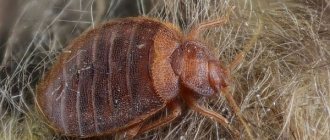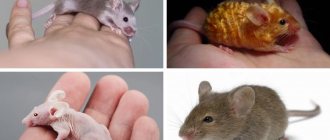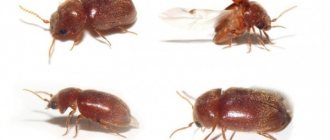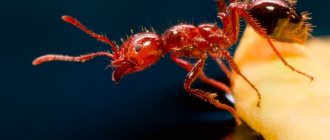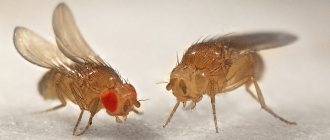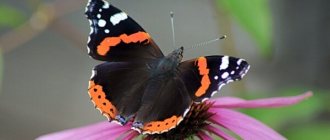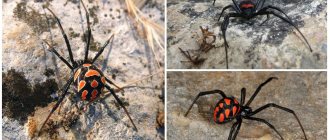Under different names
Author of the photo:
Translated from Latin, the name of the order Solifugae means “running away from the sun.” Two more names are common in the world - phalanges and bihorci.
In the dry regions of Southern Africa they are called "barbers" or "barbers". This is because local tribes have the opinion that arthropods cut off human hair, as well as animal fur, in order to equip their nests with them.
In Asia they are called camel spiders, but in Europe you can hear the names “windy scorpion” or “sun spider”. Residents of Uzbekistan and Turkmenistan call them alli gusola, which means bull's head.
2
Origin of the species and description
Photo: Solpuga
Salpugs are a group of arachnids that have various common names. Salpugs are solitary, have no venom glands and pose no threat to humans, although they are very aggressive and fast-moving and can inflict a painful bite.
The name "solpuga" comes from the Latin "solifuga" (a type of poisonous ant or spider), which in turn comes from "fugere" (to run, fly, escape) and sol (sun). These distinctive creatures have several common names in English and Afrikaan, many of which include the term "spider" or even "scorpion". Although it is neither one nor the other, "spider" is preferable to "scorpion". The term "sun spider" applies to those species that are active during the day, that seek to escape the heat and dart from shadow to shadow, often giving humans the alarming impression that they are stalking them.
Video: Solpuga
The term "red Roman" probably derives from the Afrikaans term "rooiman" (red man) due to the red-brown color of some species. The popular term "haarkeerders" means "protectors" and comes from the strange behavior of some of these animals when they use the animal barn. It seems that the female salpugs considers the hair an ideal liner for the nest. Reports in Gauteng have suggested that salpugs are cutting hair from people's heads without knowing it. Salpugs are not adapted for cutting hair, and until this is proven this must remain a myth, although they are capable of crushing the trunk of bird feathers.
Other names for salpugs include sun spiders, Roman spiders, wind scorpions, wind spiders or camel spiders. Some researchers believe that they are closely related to pseudoscorpions, but this is refuted by recent research.
Body structure
The phalanges are quite large arthropods. For example, adult Central Asian salpugs grow up to 7 cm in length. Other species average from 4 to 5 cm.
Their entire body is covered with small hairs, and their color depends on their habitat. Basically, it is sandy-yellow, brown and even whitish in color. The body is divided into three parts. The head is quite large and convex. The chest is segmented, dividing into three equal parts. But the oblong abdomen has 9–10 segments. They all look pretty scary.
In front are the pedipalps, which resemble limbs. At the end there are powerful claws covered with a powerful shield. Among arachnids, salpugs have the most powerful chelicerae, capable of biting prey in half. Three pairs of limbs are attached to the head section, and the rest to the thoracic segments. The hind limbs of salpugs are much longer than the rest.
Don’t miss the fascinating material on our website most-beauty.ru about the TOP 20 most beautiful spiders in the world.
3
Habits and lifestyle
Unlike other arachnids, they are mobile creatures. Fast predators, capable of speeds of up to 2 km per hour, hunt at night. But there are also daytime hunters. Their victims include ants, termites, species of beetles, and related arthropods. Powerful tentacles allow you to cope with lizards.
They can track their prey by chasing it and then suddenly attacking from behind. We learned to hunt from ambush. They easily gnaw through beehives and termite mounds. They track the prey with their senses of touch, their eyes, and also feel the vibration of the soil.
The lifestyle and behavior of the phalanges combine the features of primitive creatures with signs of high organization. Sensing danger, they throw the back of their body over their head and begin to squeak loudly. This frightening sound is created by the friction of the chelicerae against each other. They jump and spin in place at the same time. To hide from enemies, salpugs dig deep holes and cover the entrances with foliage.
4
Features of character and lifestyle
Photo: Camel spider in Crimea
Bihors are very active. They hunt mainly at night, although diurnal species are also found. During the winter, arthropods hibernate, and some species can do so during the summer months. They received the name “Wind Scorpion” for their ability to move at a speed of 16 kilometers per hour. Large individuals jump at a distance of more than one meter.
These creatures are aggressive, but not at all poisonous, although their bites can have serious consequences. Large individuals are capable of biting through human skin or nails. If rotting remains of their victims are present on the mandibles, they can enter the wound and cause blood poisoning or, at a minimum, inflammation.
Interesting fact: There are many different speculations about the toxicity of animals. For many centuries, salpuga was considered terribly poisonous and dangerous to human life.
The creature is absolutely not afraid of people. At night, phalanxes can easily run into the tent by the light of a lantern, so the entrance should always be closed. And when climbing inside, it’s better to check once again whether the animal has run in with you. Personal belongings also need to be kept in the tent, since a salpuga tired after a night hunt can climb into them to rest.
It is impossible to kick a bihork out of the tent. She is very nimble and persistent, so all that remains is to kill her or sweep her with a broom. It is advisable to do all this with thick gloves, and it is better to tuck your trousers into your boots. It should be remembered that it is impossible to crush an animal on the sand.
Bites
The appearance of salpugs is truly menacing. There is a myth that they are poisonous and can cause human death. But that's not true. The bite is really painful, but does not pose a danger to humans. They have neither poisonous glands nor deadly poison. Some species easily bite through human skin.
The only thing that needs to be done after a bite is to treat the wound to prevent infection. The chelicerae store rotting food debris, which can cause inflammation. And so, this is a completely harmless creature.
By the way, on our website most-beauty.ru you can find a list of the most poisonous spiders on our planet.
5
What does the phalanx spider eat?
Photo: Poisonous phalanx spider
The insect never misses an opportunity to have a snack, even when the arachnid does not feel hungry. The animal stores fat on its body to survive times when food becomes scarce. Phalanx spiders eat both living insects and those found dead. They can consume snakes, lizards, rodents, beetles and termites. However, what they will eat often depends on the location and time of year. They seem to have no problem getting food that is smaller than them. Salpugs mainly go out hunting at night.
All species of phalanx spider are carnivores or omnivores. They are aggressive hunters and voracious eaters of anything that moves. Prey is detected and captured by the pedipalps, and killed and cut into pieces by the chelicerae. The prey is then liquefied and the liquid enters the mouth. Although they do not usually attack humans, their chelicerae can penetrate human skin and cause painful bites.
The diet of the phalanx spider consists of:
- termites;
- Zhukov;
- spiders;
- scorpions;
- small terrestrial arthropods;
- snake;
- rodents;
- various insects;
- small reptiles;
- dead birds.
Phalanx spiders can prey on other predators such as bats, toads and insectivores. Some species are exclusively termite predators. Some individuals perch in the shade and ambush prey. Others catch the prey and eat it while it is still alive, vigorously tearing the flesh with sharp movements of their powerful jaws. In addition, the phalanx spider exhibits cannibalism; they always attack their relatives and the strongest wins.
Reproduction
The mating season for different types of phalanges depends on the area of settlement. Mating usually occurs at night. The female attracts males with a special smell.
The male secretes spermatophores and, with the help of chelicerae, transfers them to the genital opening of the female. This entire process takes from 2 to 4 minutes.
After mating, the male quickly runs away so that the female does not satisfy her hunger with him. In the female’s body, the development and formation of fertilized appendages occurs. During this period, she eats a lot, and after a while she lays eggs in a pre-prepared hole in the soil.
Photos and names of species
Now let’s talk in more detail about the species of salpugs that live in different parts of the world.
Phalanx spider or salpuga. Description, photos and videos of salpuga
The phalanx spider has several names - salpuga, bihorca, phalanx, camel spider, Solifugae - and is a rather unpredictable animal. Let's start with the fact that this is not a spider. Outwardly, they are very similar to spiders - the structure of the limbs, their location and the presence of chelicerae, which is why they are classified as arachnids. About 1000 types of phalanges are known.
For scientists, the name “phalanx” is not very convenient, because consonant with the Latin name of the order of harvestmen - Phalangida. The more commonly used name is “salpuga”.
Although translated from Latin it means “running away from the sun”, and this is not always true, because There are also sun-loving, diurnal species of salpugs. The name "bihora" is rarely used, and local residents of the different countries where the phalanx spider lives have their own local names for it.
Salpugs are very peculiar - their lifestyle and structure combine both signs of high development and primitive features. For example, the structure of their body and limbs is very primitive, and the tracheal system is the most developed of all arachnids.
For the most part, these are nocturnal predators, but among them there are also species that are active during the daytime.
Phalanges are quite large animals; the Central Asian phalanx can reach a length of 5-7 cm. The entire body, including the limbs, is covered with long hairs.
The pedipalp tentacles located in front are very similar to limbs and often perform their function. They look very intimidating, and it is unlikely that anyone will willingly want to get to know them better. The body of the phalanx is colored brownish-yellow.
The chelicerae are very well developed and resemble claws or large forceps. The ocular tubercle, on which there is a pair of convex eyes, is clearly visible on the anterior edge of the head shield, while the lateral eyes of salpugs are underdeveloped.
These very active animals are nocturnal predators, they are omnivores, they eat termites, darkling beetles, and other small arthropods, but they can also eat larger game - for example, a lizard. When attacking, the salpuga emits a thin squeak or chirp by rubbing the chelicerae against one another.
If the phalanx is attacked, it will begin to defend itself fiercely and is very deft in controlling its claws. She can even cope with a scorpion, although it is poisonous and very dangerous. They even behave aggressively towards each other.
Phalanxes are surprisingly voracious and indiscriminate in food. They can attack almost anything that moves and that they can handle. They can even eat termites, chewing the walls of their rather durable houses. Californian phalanxes ravage bee hives.
Larger species attack lizards, young small rodents and chicks of small birds. If there is food within its reach, the Phalanx will eat without stopping until it dies from gluttony.
Fertilized female salpugs are especially voracious. During fertilization, the female is so inert that the male sometimes drags her along with him. But after intercourse, she becomes very active, and the male has to quickly run away from her so that the female does not satisfy her hunger with him.
After some time, after actively absorbing food, the female lays eggs in a specially dug hole. There can be from 30 to 200 eggs. Young phalangeal spiders appear after 2-3 weeks.
Mating usually occurs at night. The female attracts the male with her scent. Fertilization occurs by the spermatophore method - the male releases a sticky spermatophore containing sperm, picks it up with the help of chelicerae and transfers it to the genital opening of the female.
A certain role is played by special appendages-flags on the male chelicerae. The process takes several minutes. During mating, the male behaves reflexively - if the female or spermatophore is removed, the male will still continue his actions, not noticing that now they have no meaning.
The embryonic development of small salpugs begins in the female's oviducts, so the young hatch from the laid eggs quite quickly. At first they are motionless, devoid of joints and hairs and covered with a thin transparent cuticle.
After 2-3 weeks, molting occurs, the integument begins to dismember and harden, hairs appear and the salpuga can already move. The female stays with the young until it gets stronger. According to observations, the female even delivers food to the cubs at this time.
How many times salpugs molt and what their life expectancy is is not yet known. Salpugs hibernate in winter, and some species can hibernate even during the summer months.
Phalanxes mainly live in deserts, arid regions and semi-desert areas. They can be found in the Gobi Desert, the North Caucasus, Astrakhan, Transcaucasia, the Lower Volga region, Kyrgyzstan and Kazakhstan, and in Europe they live in Greece and Spain. But in Australia they are not.
The phalanges have no poison, nor do they have poisonous glands, but their bites can have serious consequences. Large phalanges are quite capable of biting through human skin. Because their chelicerae retain the rotting remains of their victims, when they bite, they can enter the wound and cause inflammation or blood poisoning.
Different peoples give the phalanxes a variety of names - for example, “Scorpion of the Wind.” The phalanx got this name for their running, because they can reach speeds of up to 16 km/h.
There are many different fables about the toxicity of phalanges; for a long time people considered it terribly poisonous and very dangerous for humans. The phalanx itself is not at all afraid of humans, and at night it can easily run into the tent using the light of a flashlight, so always close the entrance to the tent.
When climbing into the tent, check to see if the phalanx has entered with you. Do not leave any things outside the tent; by morning a tired phalanx may crawl into them to rest.
It is impossible to drive the phalanx out of the tent; you can either kill it or throw it outside the tent with a broom. Be sure to wear thick gloves and tuck your pants into your boots. But keep in mind that it is impossible to crush it on the sand.
If you are nevertheless bitten by a phalanx, you need immediate first aid: wash the bite generously with any antiseptic - peroxide, brilliant green, iodine, even vodka or alcohol. If the wound still begins to fester, be sure to take antibiotics.
The body of the phalanges, unlike other arachnids, is divided into 3 sections - head, abdomen and thorax. The head is quite large and convex. The chest is clearly divided into three segments, like those of insects and millipedes.
The abdomen of the phalanx consists of approximately 9-10 segments; there are no limbs. Three pairs of limbs are attached to the head section, corresponding to the mandibles and two pairs of jaws in insects; there are no antennae.
The remaining three pairs are attached to the chest segments, one pair to each. The first pair of limbs is located on the anterior edge of the head and occupies it completely, facing forward.
In terms of their physiological functions, they correspond to mandibles, which is why they are called tentacle mandibles, i.e. chelicerae. They are shaped like large, thick claws; their job is to grab and chop food.
The second pair of limbs resembles tentacles (pedipalpi) in appearance, but they also look like legs, and when walking they work exactly like legs. The third pair of limbs is similar in appearance to the second and also serves for walking.
The hind legs are noticeably longer than the other limbs; on their coxae from below there are 2-5 pairs of very peculiar organs called maleolae (appendages), similar in shape to triangular plates on stalks.
Apparently, these are some kind of sensory organs; their purpose has not yet been determined. The carapaces of these pendants are equipped with sensilla with many sensitive cells; their processes are connected into one nerve passing through the stalk of each plate.
Scientists did experiments to remove maleolae, but did not find any visible changes in the behavior of salpugs in this regard.
The abdomen of the salpuga is powerful, shaped like a spindle and consists of 10 segments. Salpugs have a powerfully developed tracheal system. The body and limbs are densely covered with hairs and bristles, sometimes soft, sometimes spiny, and sometimes very long.
This shaggy appearance, combined with lightning-fast movements and large size, has a terrifying effect on enemies.
Salpugs are extremely fast, easily climb any vertical surface, and can jump more than a meter. When meeting an enemy - and for the salpug, everyone around is an enemy - she stands in a threatening pose: The front part of the body is raised, the chelicerae with open claws are directed forward, the pedipalps and front legs are also directed towards the enemy.
Some species of salpugs screech their chelicerae frighteningly, rubbing them against each other. The vast majority of salpug species are most active at night.
During the day, they hide in various secluded corners - in Georgian burrows, under stones, they can dig a hole for themselves and happily climb into your backpack or unattended shoes.
Some species always use the same shelter, while others prefer to look for a new shelter each time. Nocturnal species are easily attracted by any light source. They can come to the light of a fire or lanterns, or enter illuminated houses.
Most of all, like many nocturnal insects, they like ultraviolet radiation from a mercury lamp.
In the scientific literature there is an opinion that the salpug is attracted not by light, but by insects that have accumulated near the light source. But this is still not the case, although the salpugs that come running into the light actually begin to grab insects.
Night species have a very negative attitude towards daylight. The same cannot be said about sun-loving species, which in Spain are nicknamed “sun spiders.”
In Russia, the diurnal species includes the Central Asian sun-loving salpuga, small in size and whitish-golden in color, it can be found in the daytime in the steppes.
In 1992, the phalanx spider was listed as an endangered species in the Red Book of Ukraine.
Interesting video with phalanx
More interesting articles on the topic:
What is a flagellated spider or phryne?
Phrynes are unique in that they have six walking legs, whereas other arachnids have
Cross spider - structure and behavioral characteristics
The cross spider, or Araneus, belongs to the orb-weaver family, a genus of araneomorphic spiders
Common / Galeodes araneoides
This species, common in Russia and Central Asian countries, is also called the South Russian salpuga. In addition to the south of Russia, they are found in the steppes of Ukraine and Kazakhstan. The settlement area stretches from Egypt to Afghanistan.
Adult males reach 6 cm. Females are smaller - no more than 4.5 cm. This species has a sandy-yellow body color, and small dark spots can be seen on the back.
Zoologists believe that the type locality is located within the modern Volgograd region. This species was first described by Russian zoologist Peter Pallas. In 1772, he included the inhabitants of the southern steppes, deserts and semi-deserts in the scientific classification.
Arabian salpuga / Galeodes arabicus
The distribution area of the formidable-looking phalanx is limited to the countries of North Africa and the Arabian Peninsula. The “Arabian” predator feeds on small insects and other arthropods.
They grow up to 5 cm. The entire body and limbs are covered with long hairs. They lead a nocturnal lifestyle, and during the day they hide from the sun and enemies under stones, in burrows, and crevices.
They are not poisonous, and therefore often end up in home terrariums. At home they are quite voracious, but it is better not to overfeed.
Danger to humans
The phalanges resemble spiders in appearance and cause horror and fear in people. At the same time, they are very fast and aggressive.
The phalanx itself is not afraid of humans. She perceives any movement around her as danger. Therefore, a number of rules should be followed to minimize the possibility of a bite.
- Close windows and doors tightly at night, and in hot weather, tightly cover the windows with mesh.
- If you have to walk with a flashlight at night, you should be careful that the phalanx does not rush into the light.
- Be very careful when sitting by the fire at night.
- When spending the night outdoors, close the entrance to the tent tightly and do not light a lantern in it.
- You should not leave shoes or clothes outside overnight: the phalanx may crawl into them.
- When hiking outdoors, you should tuck your pants into your socks and wear long sleeves.
The phalanx boldly crawls towards the light of a fire or flashlight in a tent. In general, these insects love light; they are even attracted to street lights. There is an opinion that they are attracted not by light, but by midges that flock to the light. They especially love electric light and ultraviolet radiation from a mercury lamp.
If a phalanx crawls into a brightly lit house or tent, then it is almost impossible to drive it out.
You can catch and carry it out by wearing thick gloves, sweep it with a broom, or kill it. This should not be done inside the house, as this releases a dark, not very pleasant liquid. It is almost impossible to kill a salpug on the sand.
During the day, the phalanxes hide from bright light under stones and in burrows. Therefore, you should not touch stones, piles of stones, or explore animal burrows with your hands.
If your home terrarium contains a phalanx, it is not recommended to pick it up with your hands.
Smoky / Galeodes fumigatus
The inhabitant of the desert regions of Turkmenistan has a dark brown color. There are also completely black individuals. This type, of course, can scare.
They grow up to 7 cm in length, and therefore are considered one of the largest representatives of the Galeodes genus. They track their victims at night and hide in holes during the day. Some individuals use the same hole, but most find a new shelter every day.
They move quickly using walking legs. To this ability we add that they can easily overcome obstacles with a vertical surface.
Transcaspian salpuga / Galeodes caspius
This species is also known under the name Camel spider. This name has been assigned to the inhabitants of the steppes of Kazakhstan and Kyrgyzstan, but in fact it is not a spider at all. It looks very menacing, but is not dangerous to humans, as it is not poisonous.
It may hurt to bite. The species is quite aggressive. It can even attack dangerous scorpions. The giant salpuga, growing up to 7 cm, easily copes with the poisonous creature.
The color of the head and chest is brown with a slightly reddish tint. But their abdomen is grayish with dark transverse stripes.
Interesting facts about the camel spider
Photos of these salpuga spiders have brought these creatures to the forefront of many people's nightmares. In reality, there are many camel spiders with different appearances and behaviors. They are not as big and scary as their pictures might lead you to believe! Find out more about these creatures.
- No venom - these arachnids are not going to kill anyone with their venom, namely because they do not have fangs. Instead of fangs, they have modified chelicerae. They can, however, deliver a painful bite when threatened!
- As desert dwellers, these creatures deal with high temperatures. One common way to avoid the sun is to seek shade! This can lead them to follow people who think they are being followed.
- Hermit behavior - We have limited knowledge about salpuga phalanx because research can be quite difficult. They cannot be easily maintained in laboratory conditions for research. Knowledge about wild sun spiders is limited, as many live in inhospitable deserts that people tend to avoid.
- Fighting "spiders" - During World War I, soldiers caught camel spiders, scorpions and other small creatures. They placed them in cramped quarters to encourage them to fight and placed bets on which they could win.
Crimean salpuga
Among the diversity of the world of spiders of Crimea, in the foothill arid regions of the southern part of the peninsula, you can meet beautiful phalanges. Unlike tarantulas and karakurts, they are non-poisonous.
They reach a length of 5 to 6 cm. The color is light. They are active in the dark, hunting insects, small lizards, and scorpions.
This species has a complex structure of visual organs, providing them with a good reaction. They not only see the victim, but also feel its approach through the vibration of the soil. It is noteworthy that they are practically not afraid of humans and can easily join a night rest around a tourist fire.
Reproduction and lifespan of the phalanx
Mating most often occurs in the dark. The female informs the male that she is ready by emitting a special smell. The famous chelicerae of spiders also take part in the process of fertilization - it is with them that the male places the spermatophore into the genital opening of his companion.
All actions of both participants are based solely on reflexes; if for some reason the female “comes unstuck” from the male, he will still finish what he started, only to no avail. During the process of fertilization, the female practically does not move; sometimes the male simply drags her along with him. But, immediately after the end of the process, she becomes very aggressive.
Also, after mating, the female develops a sharp feeling of intense hunger, so she begins to actively hunt. If the male does not have time to quickly move away to a considerable distance, she may eat him too.
Before laying, the female digs a small hole and lays up to 200 eggs there. After 2-3 weeks, small, motionless hairless spiderlings will appear. After a few weeks, they experience their first molt, their integument becomes harder, the first hairs appear, and then the young begin to move independently. The female takes care of the spiderlings, protects them and feeds them until they reach a certain maturity and are strong enough.
In cold seasons, spiders find a relatively safe place and there they hibernate for a long time. Representatives of some species can remain in this state during the summer months. The exact number and frequency of molting of the phalanx spider is still unknown to science. There is also no substantiated information regarding the life expectancy of salpugs.
Ammotrechidae
Let's finish with a huge family that includes more than 80 species. Representatives of the family are found in arid places in North and Latin America. One known fossil species, Happlodontus proterus, was found in Dominican amber in Haiti.
All 80 species are united by zoologists into 20 genera. Night predators easily cope with termites, large insects, and small reptiles.
Almost all species were discovered in the twentieth century. Most species live in Venezuela and Chile. The image of salpug is found in the drawings of the Incas and the Mayan tribe.
Who is stronger: Salpuga or Scorpio?
Interesting Facts
Let's finish our story on most-beauty about salpug with interesting facts about these amazing arachnids.
- It is known that the species name of salpugs is “running away suns,” but in Spain they are called “sun spiders.” The Central Asian sun-loving salfug, Paragaleodes heliophilus, also runs around the steppe during the day.
- If a salpug is given a sufficient amount of food, which does not require hunting, it will eat until its belly bursts.
- Quite brave inhabitants of the planet. Without fear, she attacks animals that are many times larger than her.
- About 50 species live in the southern regions of Russia. Many of them are listed in the Red Book.
- On YouTube you can find videos where the salpuga fights against a tarantula, fights centipedes and other poisonous creatures.
- They run fast, covering 52 cm in 1 second. They can also jump up to a meter in length, and some can jump 3 meters in height.
- In 1913, the oldest fossil species, Protosolpuga carbonaria Petrunkevitch, was discovered in the United States. It was found in sediments of the Carboniferous period. Thus, the first phalanges appeared on earth 340–300 million years ago.
- Salpuga is rarely found in the mythology of peoples, but on a series of animal stamps from Kazakhstan there is a drawing of this amazing inhabitant of the steppes.
What are some interesting facts?
There are many interesting facts associated with the arachnid. When attacking, the insect scares off the attacker with a loud sound that is made when the chelicerae rub against each other. Another name is camel spider.
You can learn more about salpug from this video:
Some of the representatives are capable of jumping to a height of 1 meter. The insect can be kept at home. Feeding at home should be moderate. The arachnid has no sense of proportion.
The number of molts of the arachnid is unknown. It is also impossible to say exactly how long the phalanges live.
Conclusion
Many species are listed in the Red Book, receiving the status of endangered species. As we have learned, this is a safe predator. But salpugs, like all spiders, cause genuine fear in most inhabitants of the earth, which is why arachnophobia is the most common of all phobias.
The editors of most-beauty.ru ask you not to stand aside, but to add your opinion about salpugs in the comments to this article, and perhaps share your personal experience of meeting these amazing animals.

